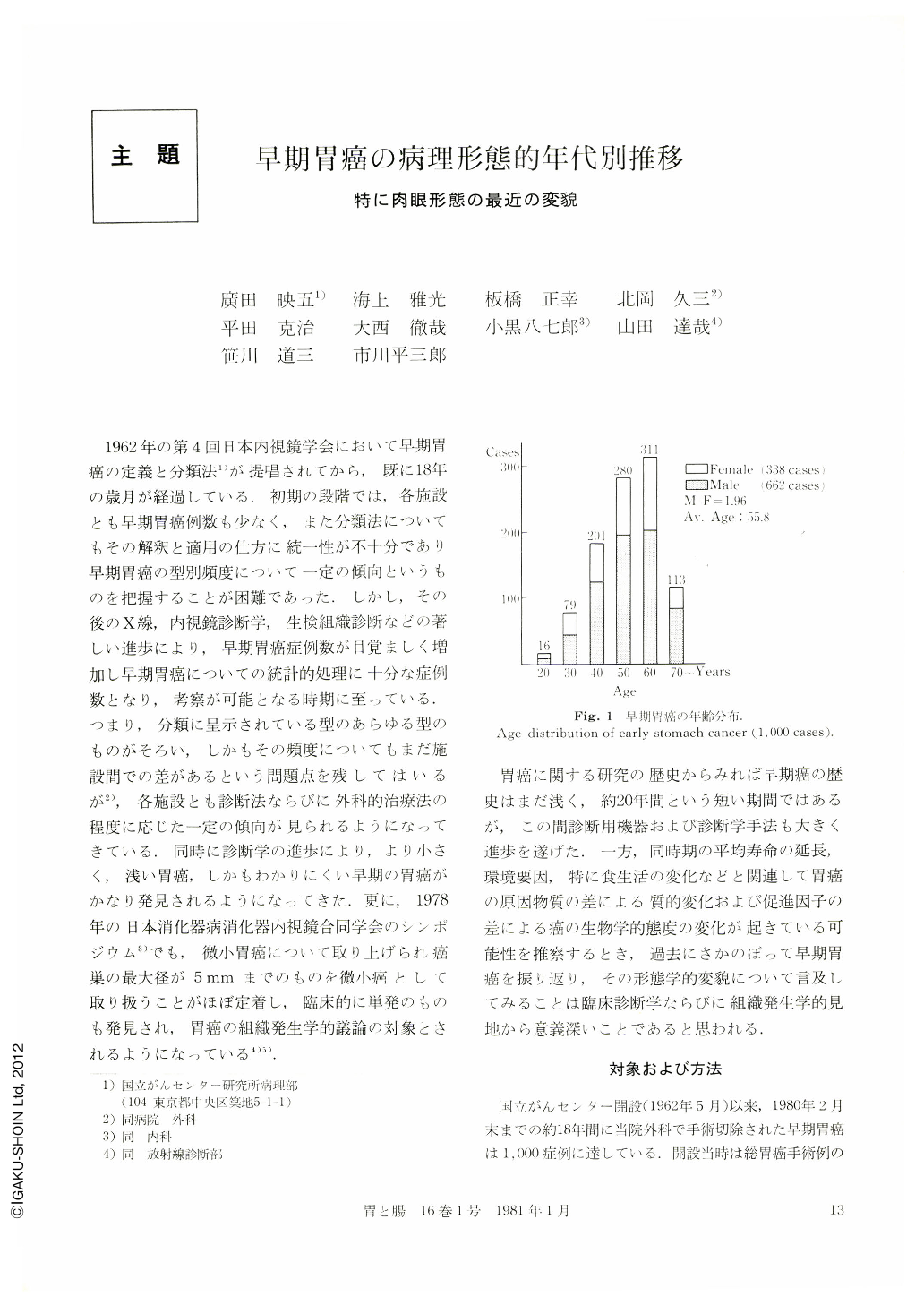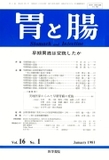Japanese
English
- 有料閲覧
- Abstract 文献概要
- 1ページ目 Look Inside
- サイト内被引用 Cited by
1962年の第4回日本内視鏡学会において早期胃癌の定義と分類法1)が提唱されてから,既に18年の歳月が経過している.初期の段階では,各施設とも早期胃癌例数も少なく,また分類法についてもその解釈と適用の仕方に統一性が不十分であり早期胃癌の型別頻度について一定の傾向というものを把握することが困難であった.しかし,その後のX線,内視鏡診断学,生検組織診断などの著しい進歩により,早期胃癌症例数が目覚ましく増加し早期胃癌についての統計的処理に十分な症例数となり,考察が可能となる時期に至っている.つまり,分類に呈示されている型のあらゆる型のものがそろい,しかもその頻度についてもまだ施設間での差があるという問題点を残してはいるが2),各施設とも診断法ならびに外科的治療法の程度に応じた一定の傾向が見られるようになってきている.同時に診断学の進歩により,より小さく,浅い胃癌,しかもわかりにくい早期の胃癌がかなり発見されるようになってきた.更に,1978年の日本消化器病消化器内視鏡合同学会のシンポジウム3)でも,微小胃癌について取り上げられ癌巣の最大径が5mmまでのものを微小癌として取り扱うことがほぼ定着し,臨床的に単発のものも発見され,胃癌の組織発生学的議論の対象とされるようになっている4)5).
胃癌に関する研究の歴史からみれば早期癌の歴史はまだ浅く,約20年間という短い期間ではあるが,この間診断用機器および診断学手法も大きく進歩を遂げた.一方,同時期の平均寿命の延長,環境要因,特に食生活の変化などと関連して胃癌の原因物質の差による質的変化および促進因子の差による癌の生物学的態度の変化が起きている可能性を推察するとき,過去にさかのぼって早期胃癌を振り返り,その形態学的変貌について言及してみることは臨床診断学ならびに組織発生学的見地から意義深いことであると思われる.
Cases of early stomach cancer, surgically resected at National Cancer Center Hospital in Tokyo during the period from 1962 to 1979 were 995 cases, which correspond to 28% of the total number of stomach cancer during the same period. In order to search chronological changes of various features like gross types as well as histological types of early stomach cancer, clinicopathological review was carried out on 995 cases. The result obtained was as follow;
(1) Age and Sex.
Cases of younger people (younger than 40 years) gradually decreased recently while elder people cases increased in the frequency. Especially cases older than 70 years have increased and reached 18% of total annual number of early stomach cancer cases in 1979. Sex ratio (male/female) had been 2/1 till 1978 but changed into 3/1 in 1979.
(2) Location.
According to CMA classification by Japanese General Rules for the Gastric Cancer Study in Surgery and Pathology, “M” area was the most frequent area of cancer (around 60% of the total cases) during the earlier period (1962~1973) of our examination, however, decreased in the frequency of cancer to 50% in contrast with increase of cancer in “A” area up to 40% during the later half period.
Frequency of cancer localization on the lesser curvature was the highest (70% of the total annual cases) during the early period but gradually decreased to 45% during the later half period, while cancer in either anterior or posterior increased up to 24% and 35%, respectively. Cancer on the greater curvature did not show noticeable change in its frequency throughout the whole period.
(3) Macroscopic Types.
Superficial, depressed type (Ⅱc) early stomach cancer occupied about 60% of the total cases in the early period and showed increase up to 74% in the later half period. In contrast to this, elevated type of early stomach cancer showed the decreasing tendency in the frequency. Flat type (Ⅱb) was slightly increased in the frequency up to 3.5% during the earlier period but decrease to 1.6% in the later period.
We tried to classify the superficial, depressed type (especially Ⅱc-type) into two subtypes; relatively deep Ⅱc-type, and relatively shallow Ⅱc-type. The two subtypes had been almost equal in the frequency during the earlier half period, however, in the later half period the relatively shallow Ⅱc-type (which is difficult to detect) increased remarkably from 64% in the Ⅳth period to 82.4% in 1979. The relatively deep well defined Ⅱc-type (typical Ⅱc) decreased to 20% in 1979.
(4) Size of the Lesions.
During the early period, large cancerous lesions were common; lesions larger than 2 cm were 80%, larger than 5 cm; 40%. During the later period, smaller lesions have become more frequent; lesions larger than 5 cm become 10%, lesions smaller than 2 cm occupied 40% of the total early stomach cancer of the year. Minute lesions smaller than 5 mm in diameter, were almost unchanged to be of 1 to 3% throughout the whole period.
(5) Histologic Types.
Differentiated type and undifferentiated type adenocarcinoma were found almost equal in the frequency during the early period. The former become more frequent than the latter to be 72% of the total cases during the later half period.
(6) Ulcer and Ulcer Scar whithin Cancerous Lesions.
Cancerous lesions with peptic ulcer therein occupied more than 90% of total depressed type early stomach cancers during the early period. They have gradually decreased in the frequency to 74.4% during the later half period.
As shown above, early stomach cancer has been changing during the examination period in their characteristic features; that is, in gross types including subtypes of depressed lesions, frequency of association of peptic ulceration, histologic types and their maximal diameter and so on. We have discussed about the factors which may have an influence on or may give a reasonable interpretation to the chronological trends of early stomach cancer written above.

Copyright © 1981, Igaku-Shoin Ltd. All rights reserved.


